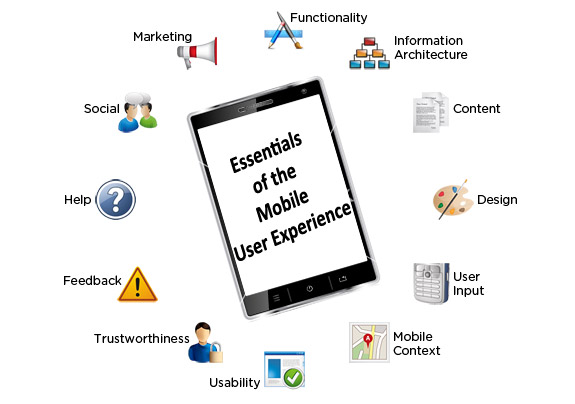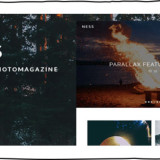The Essentials of the Mobile User Experience
Mobile device sales skyrocketed in the past years due to the significant advances in technology and modern innovative trends in the world market. According to a survey, there are currently more than 6 billion mobile subscribers equating to more than 87% of the world population. Conning the influence mobile devices have in our daily lives can give so much perspective on the achievements of modern technology as well as a potential outlook towards the future.
The mobile user experience can be an array of perceptions and feelings before, during and after their interaction with the mobile device. Those perceptions and acuity can range from an internet browser on a low-end mobile phone to an application of a high-definition tablet or mobile device.

Dichotomizing the mobile user experience into its integral constituents gives us an intangible framework for creating and evaluating excellent mobile experiences, within the circumstances of a user-centered approach for mobile structure and design. These components sculpt the mobile user experience including functionality, user-input, contextual designs, content and marketing, among others.
The significance of these elements will vary depending on the type of mobile device and the demonstration interface being used. Each of these essentials are described and elaborated with selected instructions and guidelines.
1. Functionality
When talking about functionality, mobile users consider the tools and features that enable them to complete tasks and responsibilities and achieve what they want. Since mobile users are thoroughly dependent on such elements, functionality is an important framework of every mobile device.
It is always important to prioritize and present the essential features from other networks that have deep relevance to the mobile conditions. For airline mobile applications, this includes flight schedules, statuses and check-ins. It could also have information regarding time zones in different countries that is directly linked to another network. This would induce a positive feedback from mobile users because of the efficiency of the mobile environment designed.
Mobile application and device designers are also creating relevant mobile functionality like bar-code scanning and photo and voice-recognition and enhanced features using the capabilities of the mobile devices where it is possible to engross and gratify users. There are also instances where mobile devices and application designers add a product search, an order status and a shopping cart toolbar. These are tools which are primarily used by business-inclined applications and the like. The guarantee of accuracy of your designed mobile applications and devices should always be at its optimum. Ensure that primary features, tools and contents are optimized for mobile use. Store-locators should precisely show a detailed list of branches or stores based on the mobile device’s location and make phone numbers a click-to-call.
2. Content
“What is on your website?” The statement clearly describes the content of your designed mobile application or mobile device. These are huge array of materials in varying formats such as text, videos, images, sounds and the like that provide information to users of the mobile device or application.
It is advisable that mobile designers are to present a suitable and balanced combination of content to mobile users such as product information, social content, marketing content and instruction and support content. Multimedia use is always welcome when it supports the user’s tasks in a mobile setting. Often times, multimedia content is excellent provided when the user is looking for deflection or some kind of entertainment such as humorous video clips and instructional content value like a how-to-use feature. Multimedia adds well worth to your content and reinforces the goals of your site.
At most times, some designed applications and web sites are incompatible to mobile devices with different specifications. As such, make sure that these applications and sites are optimized for mobile use and are compatible without installation of third-party software that may reduce efficiency.
3. Design
To be able to attract even the busiest person sulking in his office chair or the occupied people in their own lifestyles, visual presentation of your designed application, website or device should be at its peak. The visual presentation and interactive experience are a current reflection of the creator so application of doses of creativity can really pay off. The design of your designed mobile device, application or website includes graphic quality, branding and layout.
An excellent mobile web site, application or device interface should maintain a visual consistency with other features in the mobile device through the correct use of color and device personality. It should be designed for quick scanning and it should always be optimized for mobile devices.
4. User Input
As much as possible, reduce user input to significant fields. Use alternatives when possible such as zip codes for city and state. It is good to display default values wherever and whenever possible. Designers nowadays offer an array of alternate input mechanisms based on the mobile device’s capabilities. Some mobile applications use few input mechanisms built in the device including motion, voice, camera and video, gyroscope and location trackers. Offer the appropriate keyboard interface and the appropriate input mechanism screens to enter data. Use auto-completion and spell-check suggestions if possible. At this rate, mobile users could prevent the tedious job of typing every single data the application or the site needs. It maximizes time and energy for the mobile user and will guarantee success to the mobile designer.
5. Social
Mobile users are getting very dependent to social networking sites as they boom across the World Wide Web. As such, mobile designers tend to add the social functionality to their creations in order for mobile users to connect with people they love as well as facilitate communication to other mobile users. Usually, this function offers shared between mutual mobile users thus creating a social mark to users as well as the other members of his or her family.
It is very good to make and maintain a justifiable existence on social networking sites such as Facebook, Twitter and other local services such as Yahoo Local, Bing and Google Places. Incorporate social activity to site’s mobile experience by posting latest activity. In these ways, mobile users can readily connect to you and to other people on the Internet with just a few clicks from your own website.
6. A mobile context
A mobile device can be used at anytime, anywhere. Versatility is one major component of every mobile application or site to be on success. The mobile context is all about the environment and conditions of usage. It is very important for mobile devices being versatile because the background environment can change spontaneously and rapidly. That is why anything that affects the interaction between the user and the mobile interface should adapt to the changing context and the mobile user itself.
Automatic changes in location are very good installments in mobile applications and devices as users change their location as per travel. There are also applications that can change time and date settings depending on the time zone of the area you are located.
The features save time and effort as well as resources.
7. Trustworthiness
One thing that is very important for mobile users is their security and privacy while using your created mobile application or website. This is where your trustworthiness as the creator of the application or website enters.
The application or website should always present information tactfully. It must not collect personal information without the permission of the user. Make it easy for mobile users to control their private information before sending it to other links. Policies should be appropriately displayed at the right time and at the right place.
8. Feedback
Oftentimes, the feedback toolbar has been considered useless for mobile applications but the truth may surprise you. The feedback toolbar is very important in grabbing user’s attention and displaying essential information. Alerts should be brief and relevant to the mobile user. Notifications should be concise and informative but will not interfere with the mobile user and his or her current activity.
9. Help
In all mobile applications and sites, there is always the help link on which assistances and options are available for users with a little background of the application or web site. Always remember that the help tab should always be accessible and should always offer multiple ways on how to get support. Quick introductions and short video tutorials are very efficient in helping needs. In this way, you are offering a user-friendly application or web site to the rest of the mobile world.
Mobile user experience is an evolving field wherein mobile application designers and website developers can apply their skills in order to create efficient yet quirky apps that can reduce time and effort spurred by mobile users. It is still a developing field in which makers can explore a lot more in designing an array of applications and websites optimized for mobile but can do a lot more. Concentrating on the different elements of mobile design will create a mobile user experience that is one of a kind.








